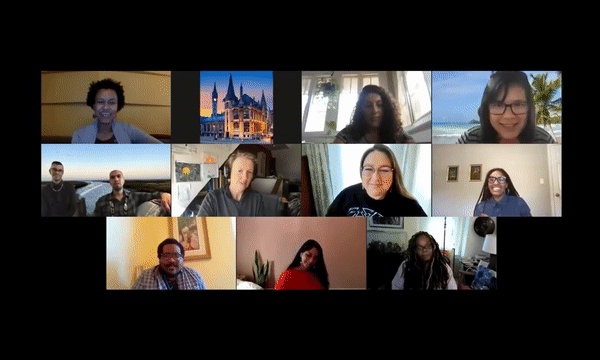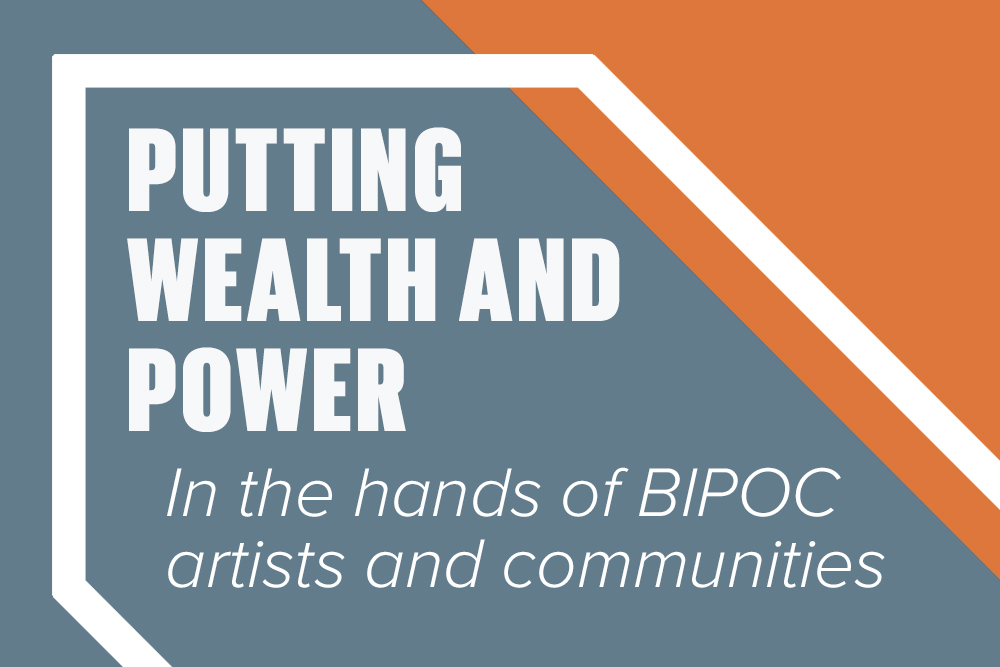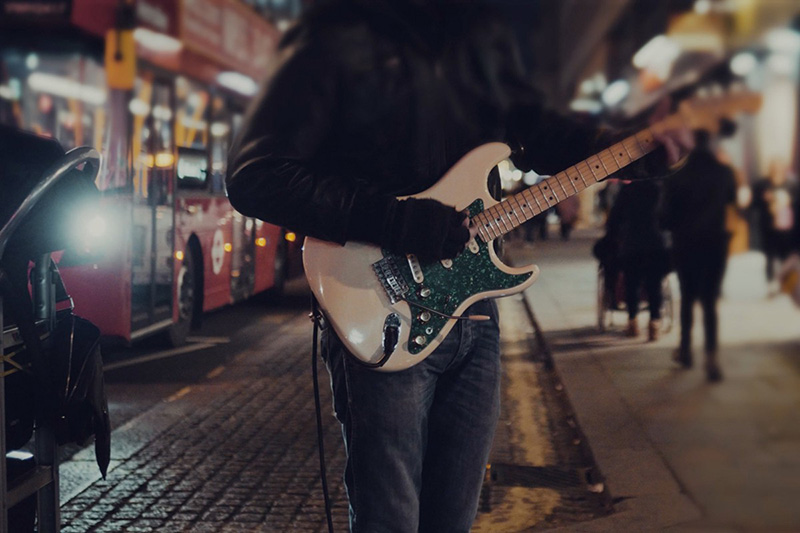Thu April 25th Open 11 AM–5 PM
Artist-Led Giving Circle: The Year in Review

Any creative who has applied for a grant can understand how intensive and exhausting the process can be. But what if there was a different model of supporting artists? A regenerative one that acknowledges artists doing groundbreaking work in their local communities, and rejects competitive dynamics? One year ago, in October 2020, a group of thirteen artists set out on a journey to radically reimagine how to distribute community wealth.
“We were gathered from across the country. We were invited to begin a new story. We met as strangers joined by common dreams. We came as dancers, dreamers, theater folk, organizers, founders, poets, doers, of all types, all lovers of Livity. Strong life. Wanting for one another what we wanted for ourselves, we became community.” – Ayodele Nzinga
Coming from communities across the country, from Oakland to New Orleans to Alaska to Dallas, the artists include: visual artist Binta Ayofemi; founder and executive director of the SF Urban Film Festival Fay Darmawi; founder and executive director of The Colored Girls Museum Vashti DuBois; multidisciplinary poet, teaching artist, and organizer Christy Namee Ericksen; founders of mak-’amham/ Ohlone Cafe Vincent Media and Louis Trevino; creative entrepreneur and culture worker Victoria Moore; transformative artist educator and Oakland poet laureate Ayodele Nzinga; artist and cultural organizer Maria Cherry Rangel; artist and co-founder of Gossypion Investments Darryl Ratcliff; artist and curator Melissa Shaginoff; musician, composer, and executive director of Northern Culture Exchange Yngvil Vatn Guttu, installation artist and community healer Allison Akootchook Warden; and artist and founder of Soul Center Erin Washington.
“We were gathered from across the country. We were invited to begin a new story.”
Brought together in September 2020, these artists formed the first ever YBCA Artist Cohort in partnership with SOCAP (Social Capital Markets). Their goal was to provide the artists with education, insight, and investment opportunities, empowering them to reframe the power dynamics of investment and rethink capital. “A lot of what we’ve been doing is really trying to exhort the system that provides capital to communities to consider the question of whether a different system would work better if we’re really trying to achieve an equitable future for us all,” Penelope Douglas, Chief of Strategy at YBCA, said.
But something unexpected and magical happened in those first meetings—all occurring virtually, in light of the pandemic. The artists expressed an interest in creating a collective body to be able to further their individual work and the more immediate needs of that work, while building towards something bigger and more deliberate. “We came into this as individual creatives, and we decided to refocus our commitment from a competition-based model, which a lot of us understand and have participated in if we wanted to or not, to a unified collective working strategy to further all of our projects,” Erin Washington said.
From that sentiment, the Artist-Led Giving Circle was born in October 2020. Inspired by traditional gifting circles, in which participants pool funds together and collectively decide how to use them in support of their communities, the Artist-Led Giving Circle aimed to use their collective wisdom to decide how to distribute community wealth. YBCA decided to step in and seed an initial $250,000 to the Giving Circle in service of this work and communities.
“When the offer originally was there to be able to divide up this money and all go our own ways, we chose intentionally to be able to work together to grow this and do the most good for our communities,” Vincent Medina explained. “You get tired after a while, always having to work to try to be able to reclaim what’s yours. We already know how to regenerate, to fish, we’ve been doing this our whole lives, ever since colonization.”
“To be able to understand how our communities have been marginalized but also to know that those values continue to shape how we interact with money reflects the shared values that are in this group about looking after one another,” Medina said. “A common good.”
Seed Money, Cede Power
In seeding the $250,000, YBCA offered the money with no strings attached, no missions to fulfill in and of itself other than the funds being used for community well-being, a concept already at the root of the artists’ work. Grant funding often comes with a series of stipulations on how the funds are used, equally enabling and binding the grantee. For YBCA, the $250,000 was about seeding the money and ceding the power—understanding that artists already know the best uses for the money and are more than capable of distributing the funds accordingly. Communities don’t need outside power coming in and dictating what change should look like—they simply need the capital to continue the work that is already in motion by local change makers. “[This funding] should be about supporting what is already happening in communities and supporting the work that is already being done because communities know what they care about and they know what it is they need to thrive and survive and continue,” Douglas said.
For everyone involved, the seed gift was a strong start, but real power emerged in the collective being formed. “We are now able to sit at the table as equals, united partners with a broad range of art projects and creative community projects across the country,” Yngvil Vatn Guttu said. “We have a different kind of power and impact.” Forming the group and creating bonds with others based on shared values and respecting each others cultures allowed the artists to deeply consider their roles both within the group and their respective communities, beyond capitalist ideas of wealth.
“We are honoring our ability to tend to one another and community.”
“Due to colonialism, so many Indigenous and other communities have been interrupted in the roles we’ve been given and confused in the path through which we can support people,” Melissa Shaginoff explained. “A lot of the ideas and notions of community and wealth and how it’s distributed in Indigenous communities through matrilineal societies… modern society can benefit from,” she said.
For Shaginoff, working with institutions to regift any power or privilege or funds can be viewed as an act of decolonizing and an extension of a cultural practice: Indigenous potlatch ceremonies. “These ideas of being attached to institutional power and trying to decolonize them is not trying to undo them because they’re inherently colonial. It’s more trying to make space for the projects we care about and infiltrate it and use whatever sort of powers we have within those places to give to other people, to potlatch them to other people.”
Building a New World From Scratch
Over the next few months, the collective began a series of discussions and labor-intensive work, envisioning a new funding ecosystem and building it up, brick by brick, dialogue by dialogue, Zoom chat message by Zoom chat message. Everything from decision-making processes to dealing with conflict, they decided and built themselves, with the guidance of YBCA and other consultants requested by the group.
One of the first decisions the group made by consensus was to disburse an initial gift to each of the members, to address urgent financial needs and redistribute to their respective communities. “While we take our time to engage in the processes that will ultimately guide our circle, we feel compelled to respond to this immediate need. We are honoring our ability to tend to one another and community,” the collective wrote of their decision.
The gifts were used in a number of different ways to aid the well-being of their communities. Some forwarded the entire sum to their organizations, some split up the gift into smaller microgrants for artists in their communities. Artists bought materials, covered medical expenses, created a mini giving circle, and even received some money back from regenerative-minded (and -abled) recipients. One member was even able to fund the work of a drum maker, a fellow member of her Indigenous community whose practice is of utmost cultural significance but overlooked by typical institutional support.
These microgrants are an incredible manifestation of the group’s work, but the Giving Circle’s impact is much deeper. The network they are creating, the presence that they individually bring to the table paired with the solidarity they share is the real work, the real investment, the real gift. That power is what magnifies the monetary disbursements, microgrants, or however else funds are distributed.
The Circle is about more than giving artists money. It’s about understanding and recognizing artists as agents of change who deserve a say in how wealth is redistributed. “We’re not only here to impact our own communities. We’re here to impact the entire financial social investment community,” Fay Darmawi said. “We are here to upend it completely and say if you don’t have an artist on your underwriting committee, you are not making systems change when you don’t have the actual change makers. It’s not you giving us money. We need to be at your table telling you how to give your money.”
Time to Dream
Throughout the last year, the Giving Circle has done the very thing artists and leaders so rarely have the opportunity to do: dream, envision, imagine, learn, unlearn, remake, and transform. They have a mission, and they remain nimble, ready to jump into action and respond to emergent opportunities, but they have been able to take the time they need to create a model that is intentional and purposeful, taking advantage of how rare but abundant a resource time is.
“Colonization wants us to tell very linear stories and the ways that so many of us tell stories, even our process in this space, has been nonlinear in so many ways, and I want to uplift that as a value,” Maria Cherry Rangel said of their work.
“It’s about understanding and recognizing artists as agents of change who deserve a say in how wealth is redistributed.”
The Giving Circle dreamed up different funding models and economic models, looking to age-old ingenuity and existing modern, non-capitalist methods to create something truly regenerative. “We can look at really sophisticated indigenous practices and ways that we help regenerate each other in our current lives,” Binta Ayofemi explained. ”We can use that inspiration in creating the fund.”
They explored what success would look like, and also reframed failure and the pressures put on them as BIPOC artists. “A lot of times, at least in my experience in art and cultural spaces particularly as a black person, and for many people of color, failure isn’t celebrated or encouraged or given much space for or funded,” Darryl Ratcliff explained. “And I think it’s really interesting. Can this be a space that helps fund that experimentation, that failure that you need to get to where we all want to go?”
Connecting Virtually
A group of strangers coming together for a series of workshops and finding so much solidarity that they decided to form a collective is remarkable—what’s even more remarkable is that this all happened virtually. Every month the group met (mostly on Zoom), calling in from home offices, studios, community spaces, cars, parking lots, on set, and more and were able to establish trust and a rare kind of kinship that comes with building something radical with each other and for each other.
“There’s something too that I find interesting, just across the geographical spaces that we’re in,” Victoria Rae Moore explained, of creating the collective virtually. “[With this work,] you imagine people interacting in physical space with one another, and we don’t do that at all yet. That’s something that speaks really loudly to this particular moment in history. There’s so much discovery happening in this group coming together and the processes that we’re forging along the way.”
The Artist-Led Giving Circle continues their work to develop a regenerative model for funding that acknowledges and supports BIPOC artists like themselves and the everyday groundbreaking work that they do for their communities. Every day, they are building the future itself—drawing knowledge from their ancestors to create a world fit for their own descendants.
“I’m thinking of the great great grandchildren of this group,” Allison Akootchook Warden said. “When we’re thinking of the future, we’re thinking about young people and helping young people create something new or learn from what we created. We can give tools and guidelines for people who are looking at alternative models and the future.”

